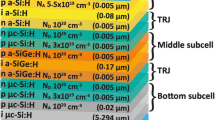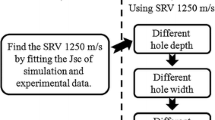Abstract
This article focuses on the modeling and simulation of thin-film silicon solar cells to obtain increased efficiency. Computer simulations were used to study the performance limits of tandem and triple-junction, silicon-based solar cells. For the analysis, the optical simulator SunShine, which was developed at Ljubljana University, and the optoelectrical simulator ASA, which was developed at Delft University of Technology, were used. After calibration with realistic optical and electrical parameters, we used these simulators to study the scattering properties required, the absorption in nonactive layers, antireflective coatings, and the crucial role of the wavelength-selective intermediate reflector on the performance of the solar cells. Careful current matching was carried out to explore whether a high photocurrent [i.e., more than 15 mA/cm2 for a tandem hydrogenated amorphous silicon (a-Si:H)/hydrogenated microcrystalline silicon (μc-Si:H) solar cell and 11 mA/cm2 for a triple-junction a-Si:H/amorphous silicon germanium (a-SiGe:H)/μc-Si:H solar cell] could be obtained. In simulations, the extraction of the charge carriers, the open-circuit voltage, and the fill factor of these solar cells were improved by optimizing the electrical properties of the layers and the interfaces: a p-doped, a-SiC layer with a larger band gap (EG > 2 eV) and buffer layers at p/i interfaces were used. Simulations demonstrated that a-Si:H/μc-Si:H solar cells could be obtained with a conversion efficiency of 15% or higher, and triple-junction a-Si:H/a-SiGe:H/μc-Si:H solar cells with an efficiency of 17%.










Similar content being viewed by others
References
SILVACO, Data Systmes Inc., Santa Clara, CA, http://www.silvaco.com/products/device_simulation/atlas.html
Crosslight Software Inc., Vancouver, Canada, http://www.crosslight.com/Product_Overview/prod_overv.html#APSYS
Synopsis Inc., San Jose, CA, http://www.synopsys.com/products/tcad/taurus_medici_ds.html
J.K. Arch, F.A. Rubinelli, J-Y. Hou S.J. Fonash: Computer analysis of the role of p-layer quality, thickness, transport mechanisms, and contact barrier height in the performance of hydrogenated amorphous silicon p-i-n solar cells. J. Appl. Phys. 69, 7674 1991
F. Smole, M. Topic J. Furlan: Amorphous silicon solar cell computer model incorporating the effects of TCO/a-Si:C:H junction. Sol. Energy Mater. Sol. Cells 34, 385 1994
M. Zeman, J.A. Willemen, L.L.A. Vosteen, G. Tao J.W. Metselaar: Computer modeling of current matching in a-Si:H/a-Si:H tandem solar cells on textured substrates. Sol. Energy Mater. Sol. Cells 46, 81 1997
M. Burgelman, P. Nollet S. Degrave: Modeling polycrystalline semiconductor solar cells. Thin Solid Films 361–362, 527 2000
A. Froitzheim, R. Stangl, L. Elstner, M. Kriegel W. Fuhs: AFORS-HET a computer program for the simulation of heterojunction solar cells to be distributed for public use in Proceedings of the 3rd World Conference on Photovoltaic Energy Conversion, Osaka, Japan, 2003 p. 1P–D3–34
M. Burgelman, J. Verschraegen, S. Degrave P. Nollet: Modeling thin-film PV devices. Prog. Photovolt. Res. Appl. 12, 143 2004
T. Sawada, H. Tarui, N. Terada, M. Tanaka, T. Takahama, S. Tsuda S. Nakano: Theoretical analysis of textured thin-film solar cells and a guideline to achieving higher efficiency in Proceedings of the 23rd IEEE Photovoltaic Specialist Conference, Louisville, KY, 1993 803
A. Fantoni, M. Vieira, J. Cruz, R. Schwarz R. Martins: A two-dimensional numerical simulation of a non-uniformly illuminated amorphous silicon solar cell. J. Phys. D: Appl. Phys. 29, 3154 1996
J. Zimmer, H. Stiebig H. Wagner: Investigation of the electronic transport in PIN solar cells based on microcrystalline silicon by 2D numerical modeling in Amorphous and Microcrystalline Silicon Technology—1998, edited by R. Schropp, H.M. Branz, M. Hack, I. Shimizu, and S. Wagner Mater. Res. Soc. Symp. Proc. 507 Warrendale, PA 1999 377
J. Furlan, S. Amon, P. Popovič F. Smole: Internal opto-electrical properties of p-i-n a-Si:H solar cells on grooved TCO texture in Proceedings of the 1st World Conference on Photovoltaic Energy Conversion, Hawaii, 1994 658
Ch. Haase H. Stiebig: Thin-film silicon solar cells with diffractive elements in Proceedings of the 21st EU PVSEC, Dresden, Germany, 2006 1712
K. Brecl, D. Fischer, F. Smole M. Topic: 2-D model for simulation of electrical losses in an amorphous silicon thin-film module in Proceedings of the 21st European Photovoltaic Solar Energy Conference and Exhibition, Dresden, Germany, 2006 1662
J. Krc, F. Smole M. Topic: Analysis of light scattering in amorphous Si:H solar cells by a one-dimensional semi-coherent optical model. Prog. Photovolt. Res. Appl. 11, 15 2003
R.I.E. Schropp M. Zeman: Amorphous and Microcrystalline Solar Cells: Modeling, Materials, and Device Technology Kluwer Academic Publishers Amsterdam, The Netherlands 1998
F. Leblanc, J. Perrin J. Schmitt: Numerical modeling of the optical properties of hydrogenated amorphous-silicon-based p-i-n solar cells deposited on rough transparent conducting oxide substrates. J. Appl. Phys. 75, 1074 1994
Delft University of Technology: ASA simulator, User’s manual v5.0 Delft University of Technology Delft, The Netherlands 2005
J. Springer, A. Poruba M. Vanecek: Improved three-dimensional optical model for thin-film silicon solar cells. J. Appl. Phys. 96, 5329 2004
J. Muller, B. Rech, J. Springer M. Vanecek: TCO and light trapping in silicon thin film solar cells. Sol. Energy 77, 917 2004
M. Zeman, R.A.C.M.M. van Swaaij, J.W. Metselaar R.E.I. Schropp: Optical modeling of a-Si:H solar cells with rough interfaces: Effect of back contact and interface roughness. J. Appl. Phys. 88, 6436 2000
J. Krc, M. Zeman, O. Kluth, F. Smole M. Topic: Effect of surface roughness of ZnO:Al films on light scattering in hydrogenated amorphous silicon solar cells. Thin Solid Films 426, 296 2003
M. Zeman, R. van Swaaij, E. Schroten, L.L.A. Vosteen J.W. Metselaar: Device modelling of a-Si:H alloy solar cells: Calibration procedure for determination of model input parameters in Amorphous and Microcrystalline Silicon Technology—1998, edited by R. Schropp, H.M. Branz, M. Hack, I. Shimizu, and S. Wagner Mater. Res. Soc. Symp. Proc 507 Warrendale, PA 1999 409–414
B.E. Pieters, J.W. Metselaar M. Zeman: Modeling of μc-Si:H solar cells in Proceedings of the 20th European Photovoltaic Solar Energy Conference, edited by W. Palz, H.A. Ossenbrink, and P. Helm, Barcelona, Spain, 5–10 June 2005, pp. 1643–1646 [CD ROM]
J. Krc, G. Cernivec, A. Campa, J. Malstrom, M. Edoff, F. Smole M. Topic: Optical and electrical modeling of Cu(In,Ga)Se2 solar cells. Opt. Quantum Electron. 38, 1115 2006
D. Fischer, S. Dubail, J.A.A. Selvan, N.P. Vaucher, R. Platz, Ch. Hof, U. Kroll, J. Meier, P. Torres, H. Keppner, N. Wyrsch, M. Goetz, A. Shah K.D. Ufert: The “micromorph” solar cell: Extending a-Si:H technology towards thin film crystalline silicon in Proceedings of the 25th IEEE Photovoltaic Specialist Conference, Washington, DC, 1996 1053
K. Yamamoto, A. Nakajima, M. Yoshimi, T. Sawada, S. Fukuda, T. Suezaki, M. Ichikawa, Y. Koi, M. Goto, T. Meguro, T. Matsuda, M. Kondo, T. Sasaki Y. Tawada: High efficiency thin film silicon hybrid cell and module in Proceedings of the 15th Photovoltaic Solar Energy Conference and Exhibition, Shanghai, People’s Republic of China, 2005 529
S. Guha J. Yang: Thin film silicon photovoltaic-from R&D to commercialization in Proceedings of the 15th Photovoltaic Solar Energy Conference and Exhibition, Shanghai, People’s Republic of China, 2005 35
A.V. Shah, H. Schade, M. Vanecek, J. Meier, E. Vallat-Sauvain, N. Wyrsch, U. Kroll, C. Droz J. Bailat: Thin-film silicon solar cell technology. Prog. Photovolt. Res. Appl. 12, 113 2004
J. Meier, J. Spitznagel, U. Kroll, C. Bucher, S. Fay, T. Moriarty A. Shah: Potential of amorphous and microcrystalline silicon solar cells. Thin Solid Films 451–542, 518 2004
J. Krc, M. Zeman, A. Campa, F. Smole M. Topic: Novel approaches of light management in thin-film silicon solar cells in Amorphous and Polycrystalline Thin-Film Silicon Science and Technology—2006, edited by S. Wagner, V. Chu, H.A. Atwater, Jr., K. Yamamoto, and H-W. Zan Mater. Res. Soc. Symp. Proc 910, Warrendale, PA 2007 A25–01
M. Konagai inProceedings of the 2nd Workshop on The Path to Ultra-High Efficiency Photovoltaics Joint Research Centre Ispra, Italy 2002 118
M. Kambe, M. Fukawa, N. Taneda, Y. Yoshikawa, K. Sato, K. Ohki, S. Hiza, A. Yamada M. Konagai: Improvement of light-trapping effect on microcrystalline silicon solar cells by using high haze transparent conductive oxide films in Proceedings of the 3rd World Conference on Photovoltaic Energy Conversion, Osaka, Japan, 2003 5P–D4–24
J.A. Anna Selvan, A.E. Delahoy, S. Guo Y. Li: A new light trapping TCO for uc-Si:H solar cells in Proceedings of the 14th Photovoltaic Solar Energy Conference and Exhibition, Bangkok, Thailand, 2004 179
J. Meier, U. Kroll, J. Spitznagel, S. Benagli, T. Roschek, G. Pfanner, C. Ellert, G. Androutsopoulos, A. Hügli, M. Nagel, C. Bucher, L. Feitknecht, G. Büchel A. Büchel: Progress in up-scaling of thin-film silicon solar cells by large-area PECVD KAI systems in Proceedings of the 31st PV Specialists Conference 2005, Florida, 2005 1464
M. Kondo: Key issues for high performance thin film Si solar cells in Proceedings of the 15th Photovoltaic Solar Energy Conference and Exhibition, Shanghai, People’s Republic of China, 2005 43–4
Acknowledgments
The authors thank W. Reetz, H. Stiebig, and B. Rech from Research Centre, Juelich, Germany, for providing the experimental data for the micromorph silicon solar cell. Bart Pieters from Delft University of Technology is acknowledged for developing the current version of the ASA simulation program. This work has been partially funded by the Dutch SenterNovem agency.
Author information
Authors and Affiliations
Corresponding author
Rights and permissions
About this article
Cite this article
Zeman, M., Krc, J. Optical and electrical modeling of thin-film silicon solar cells. Journal of Materials Research 23, 889–898 (2008). https://doi.org/10.1557/jmr.2008.0125
Received:
Accepted:
Published:
Issue Date:
DOI: https://doi.org/10.1557/jmr.2008.0125




